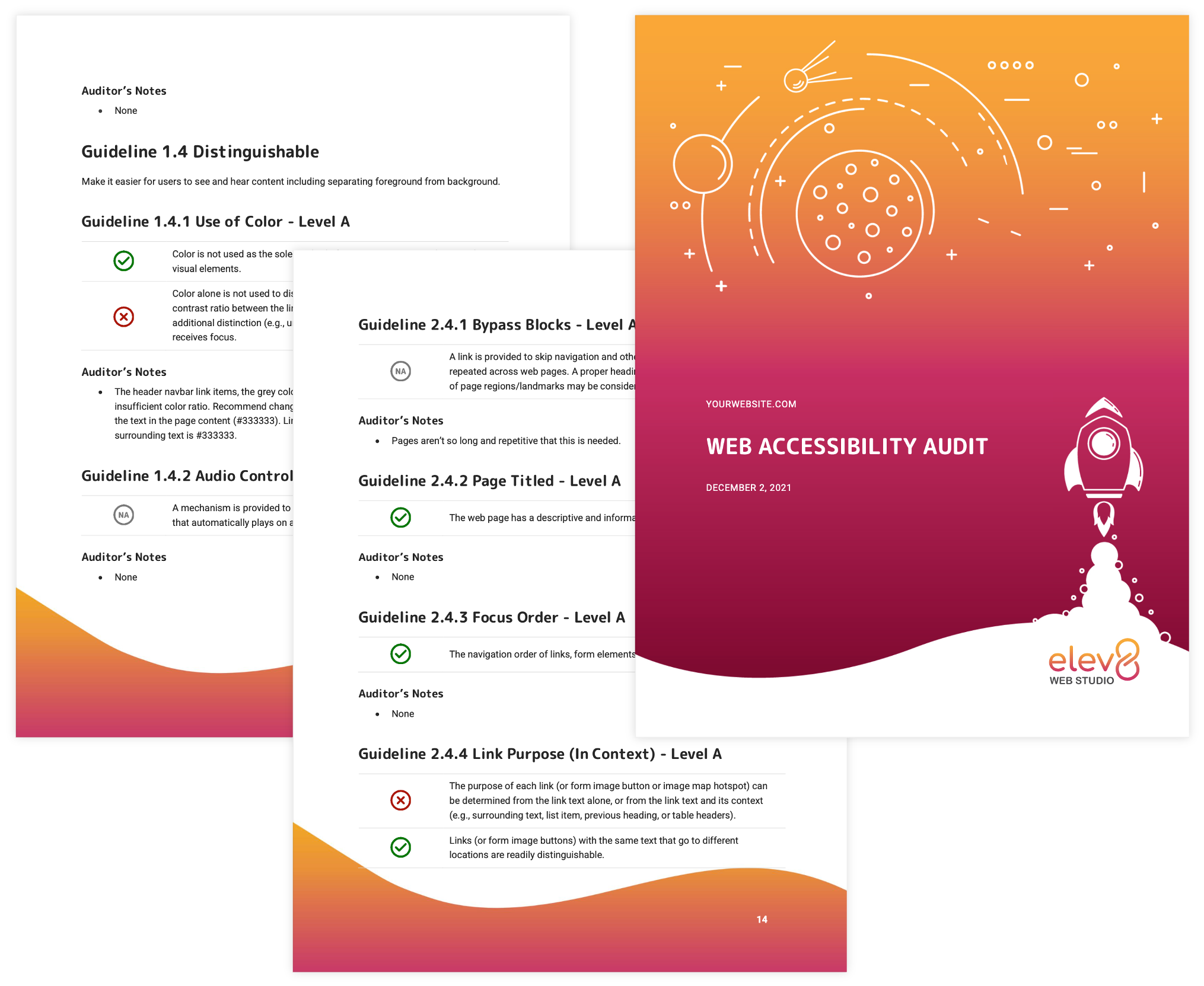In an era where the digital landscape is as diverse as its users, ensuring the accessibility of websites transcends mere good practice—it’s imperative. With the stakes including not just the potential to exclude significant portions of the population but also legal ramifications, the importance of web accessibility has never been clearer or more urgent.
The Limitations of Automated Accessibility Tools
Automated tools, often referred to as “overlay solutions” or “bolt-on solutions”, promise to make websites accessible with minimal effort by layering additional code on top of existing content. However, despite their appealing marketing, these products frequently fall short of delivering a truly accessible experience. Critics and advocates within the accessibility community have raised significant concerns about the efficacy of such tools, arguing that they offer little real value to end-users, particularly those with disabilities. Here’s where professional Accessibility Assessments and Audits come into play, offering a depth of analysis and insight that automated tools simply cannot match. Here are some of the limitations of these tools:
- Complexity of Human Experience: Accessibility tools often struggle to fully grasp the nuanced and complex ways individuals with disabilities interact with digital content. For instance, the subjective nature of certain accessibility requirements, like ensuring content is understandable and operable, can be challenging for automated tools to assess accurately.
- Automated vs. Manual Testing: Many accessibility issues require human judgment to evaluate. For example, automated tools can check for the presence of alt text on images, but they can’t judge the quality or relevance of that alt text. Similarly, tools may identify the use of ARIA (Accessible Rich Internet Applications) attributes but cannot ascertain if they are implemented correctly to aid navigation for screen reader users.
- Limitations in Detecting Contextual Issues: Automated tools may not effectively identify issues that depend on the context within which content is presented. This includes understanding the sequence of headings, the appropriateness of link text in giving users a clear indication of where a link will take them, and ensuring that interactive elements are logically ordered and accessible.
- Technological Constraints: The dynamic nature of web technologies and the constant evolution of web standards pose a challenge for automated tools to stay updated. Some advanced web features and interactive elements might not be fully supported or accurately assessed by these tools.
- Variability Among Users and Tools: Accessibility needs vary greatly among users, and what works for one individual may not work for another. Automated tools can’t account for all possible user interactions and preferences. Additionally, different tools may yield different results for the same content, leading to inconsistencies in identifying and addressing accessibility issues.
- Overreliance Can Lead to Complacency: There’s a risk that developers and organizations might rely too heavily on automated tools, assuming that a lack of identified issues equates to full accessibility. This complacency can prevent further manual testing and consideration of user feedback, which are critical components of an accessible digital environment.
A Comprehensive Approach to Accessibility
True digital accessibility requires a thoughtful approach to web design and content management that adheres to established guidelines and principles. This ensures websites are navigable, understandable, and usable for everyone, regardless of their physical or cognitive abilities.
Steps Toward Improved Accessibility
Businesses and web developers committed to accessibility should consider the following steps to enhance website accessibility:
Invest in Education
Provide formal accessibility training for your team to stay informed about best practices and evolving standards.
Regular Reviews
Schedule professional accessibility assessments regularly to identify and fix potential barriers.
Comprehensive Solutions
Focus on design and content strategies that prioritize accessibility from the ground up, rather than relying on automated tools.
Community Engagement
Work with accessibility advocates and individuals with disabilities to understand the practical impact of your website’s design choices.
Understanding Accessibility Assessments and Audits
A professional review does more than tick boxes—it offers a comprehensive analysis that automated tools can’t replicate, assessing compliance with the Web Content Accessibility Guidelines (WCAG). These standards are not only best practices but are also mandated under laws like the Access to Ontarians with Disabilities Act (AODA) and the Americans with Disabilities Act (ADA) in various jurisdictions.
Why choose a professional Accessibility Assessment or Audit?
At Elev8, our detailed assessment provides a report that grades each WCAG criterion, offering clear guidance on areas needing improvement. This level of detail, encompassing roughly 30 pages, is essential for organizations aiming to navigate the complexities of web accessibility effectively.
Legal Compliance
For many organizations, particularly in Ontario under the AODA, along with similar legislation elsewhere, ensuring accessibility compliance is not optional. It’s a legal requirement, particularly for public sector entities and businesses or non-profits with 50 or more employees.
Thorough Evaluation
Our Accessibility Assessments focus on key elements like headers, footers, and select pages to understand site accessibility. This method suits most clients, identifying common issues. For a comprehensive review or certification, our Audit service covers all pages and templates.
Expert Insight
While there are numerous free online tools available, the intricate nature of web accessibility demands expert interpretation. The context-dependent rules of web accessibility require experienced auditors who can apply their understanding beyond what automated tools can infer.
Comparing Accessibility Assessments and Audits: What Are the Key Differences?
Evaluating the accessibility of your website is crucial for ensuring it is inclusive and user-friendly. We offer two distinct services:
- Accessibility Assessment: This approach focuses on examining key components of your site, such as the header, footer, and a selection of representative pages or templates. It’s designed to provide a snapshot of your website’s overall accessibility landscape. Most clients find this option suits their needs best, as the issues identified during an Assessment are often indicative of broader trends that can be found across the site. Findings from the Assessment can guide the review of additional content, helping to ensure a comprehensive improvement in accessibility.
- Accessibility Audit: Following the same methodology as the Assessment, the Audit goes a step further by encompassing a more exhaustive examination of your site, including all pages and templates. The outcome is a detailed report that mirrors that of an Assessment in structure and content but is grounded in a more thorough investigation. This option is particularly beneficial for larger organizations or those subject to more stringent regulatory requirements, offering a formal certification of compliance. It’s ideal for public companies, government entities, or any organization with dedicated compliance initiatives and/or specific auditing requirements.
It’s important to note that our services are most effective for websites that primarily deliver content. Complex web applications may require a more specialized approach to accurately assess and address accessibility concerns.

Conclusion
For businesses serious about their commitment to accessibility, investing in a professional accessibility review is the best step forward. Not only does it demonstrate a commitment to accessibility, but it also protects against potential legal challenges while ensuring that your website serves all users effectively.
Let’s move beyond the limitations of automated tools and embrace comprehensive, expert-driven approaches to web accessibility.
Take the first step towards ensuring your website is accessible to everyone. Our professional Accessibility Assessment and Audit services are designed to provide you with a comprehensive understanding of how your site measures up against the WCAG standards. Don’t rely on automated tools that might miss the nuanced requirements of true accessibility. Contact us today, and let’s work together to create an inclusive digital experience for all your users.


